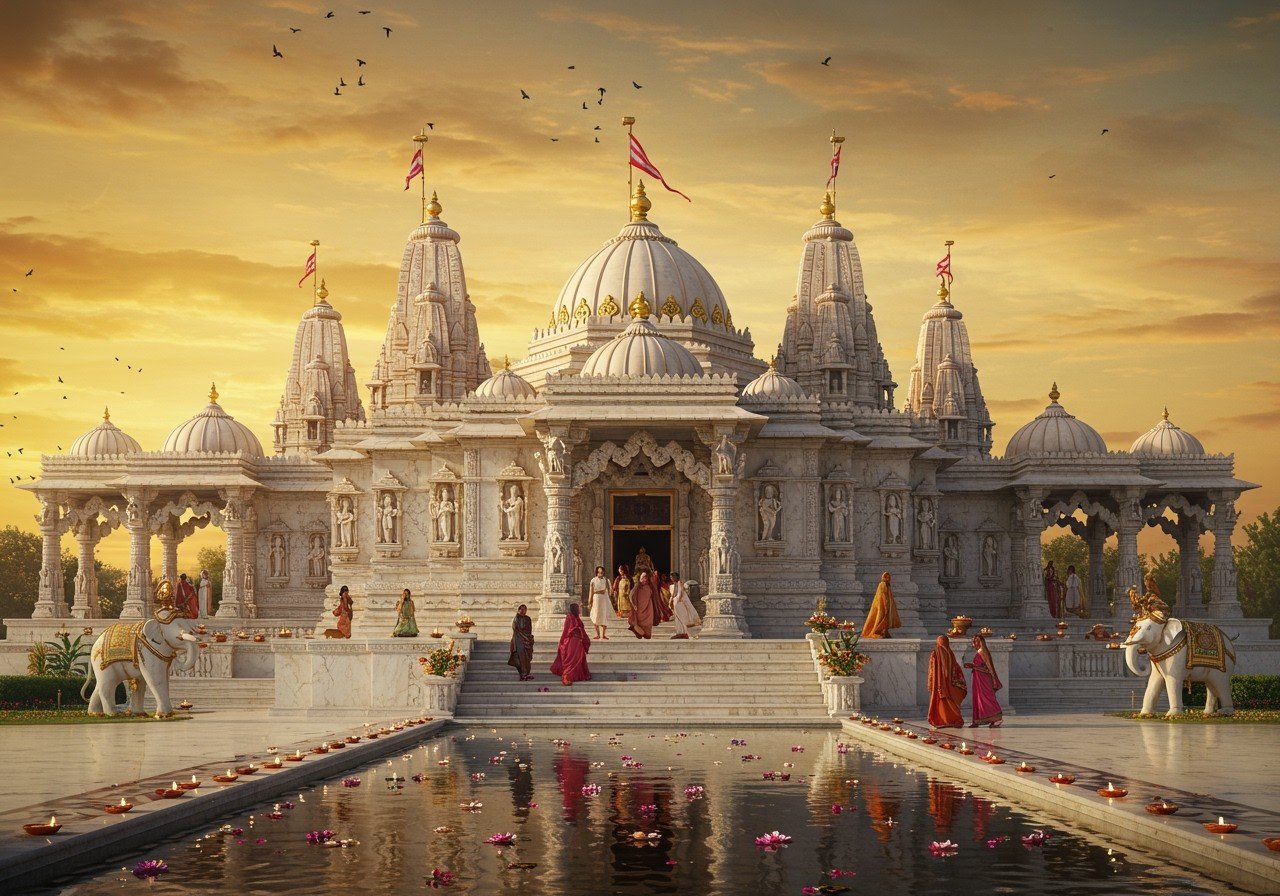
Swaminarayan temples are renowned for their intricate artistry and serene spiritual atmosphere. These sacred spaces serve as both sanctuaries for worship and repositories of cultural heritage. They beautifully blend symbolic representation with time-honored craftsmanship, reflecting the essence of Indian spirituality and architectural brilliance. Let’s delve into the captivating world of Swaminarayan temple art and architecture.
Hindu Iconography and Symbolism
Swaminarayan temple architecture is replete with profound symbolism, drawing heavily from Hindu iconography. The lotus flower, a recurring motif, embodies purity and divine beauty. Intricate mandala patterns, symbolizing the cosmos and spiritual enlightenment, often adorn the temple’s surfaces. Deities represented in the temple art, such as Nar Narayan Dev, Radha Krishna Dev, Dharmadev, Bhakti Mata, and Lord Swaminarayan, personify virtues and impart sacred teachings. Furthermore, the elaborate carvings frequently narrate captivating mythological stories.
Architectural Styles and Features
Swaminarayan temples exhibit a diverse range of architectural influences, incorporating elements from Gujarati, Rajasthani, and Marwari traditions. The prominent Nagara style is characterized by its ornate domes, intricate carvings, and sculpted pillars. Inspired by the Māru-Gurjara architecture, temples like the Akshardham in Delhi, the world’s largest comprehensive Hindu temple, showcase magnificent structures built with Rajasthani pink sandstone and Italian Carrara marble. Shikhars (spires) symbolize mountain peaks, while the numerous columns evoke the imagery of a dense forest. Recessed shrines resemble caves, providing tranquil spaces for contemplation. Many temples feature walkways designed for circumambulation, often embellished with intricate designs and inlaid marble. The practice of separate sections for men and women within the main shrine area aims to foster a deeper concentration during worship.
The Art of Murti Making
Murtis, or deity sculptures, occupy a central role in Swaminarayan temples. These sacred images are meticulously crafted using traditional techniques, often from materials like marble and wood, chosen for their spiritual significance. The artistic process involves intricate design, careful carving, and precise installation. Color and adornment further enhance the divine presence of the murti, playing a crucial role in daily rituals and celebrations. You can bring this sacred art into your own home with a Swaminarayan murti for home worship from Poojn.in. Explore a variety of options to create a personal spiritual sanctuary.
Swaminarayan Temple Art at Home
Integrating Swaminarayan temple art into your home decor can infuse your living spaces with beauty and spiritual significance. A Swaminarayan murti serves as a focal point for personal devotion and contemplation. Consider adorning your walls with Swaminarayan-themed artwork, such as drawings and paintings, to create a serene and uplifting ambiance. Poojn.in offers a diverse selection of authentic temple art and ritual items, including Lord Shiva murtis and Ladoo Gopal murtis, making it convenient to cultivate a sacred atmosphere in your home. Our range of standing Shiva murtis and Ganga Shiva murtis are perfect for creating a dedicated space for prayer and reflection. Transform your home into a haven of peace and devotion with these exquisite pieces.
Exploring Swaminarayan Temples Online
The digital age provides readily accessible opportunities to explore the magnificence of Swaminarayan temples from anywhere in the world. Virtual tours offer immersive experiences, allowing you to appreciate the intricate details of these structures without leaving your home. Online resources and digital art collections provide valuable insights into the history and craftsmanship behind the temples. Engage with online communities and forums to share experiences and connect with fellow enthusiasts of Swaminarayan spirituality. Social media platforms also serve as a means of fostering global appreciation for the unique art and architecture of these temples. You can find more info about visiting these beautiful temples on Poojn.in’s blog.
FAQs on Swaminarayan Temple Art & Architecture: A Detailed Exploration
What distinguishes Swaminarayan Temple art and architecture? Swaminarayan Temple art and architecture stand out for their intricate carvings, detailed sculptures, and use of traditional Indian architectural styles. Often using marble and sandstone, these temples frequently depict scenes from Hindu mythology and the life of Swaminarayan.
Is it possible to purchase a Swaminarayan murti for my home? Yes, acquiring a Swaminarayan murti for your home is possible. Numerous online stores, including Poojn.in, offer authentic murtis crafted from materials like marble, brass, or wood. Ensure you choose a reputable source to guarantee quality and authenticity.
How can I create a Swaminarayan drawing incorporating color? To create a colored Swaminarayan drawing, begin by sketching the outline using a pencil, referencing images for accuracy. Once satisfied, use colored pencils, watercolors, or acrylic paints to bring the drawing to life, emphasizing the vibrant colors commonly seen in temple art.
Are there specific architectural elements of Swaminarayan temples to consider for home design inspiration? When designing a home inspired by Swaminarayan temple architecture, focus on elements like ornate doorways, intricate carvings, and the use of marble or sandstone. Incorporate traditional motifs and patterns that reflect the temple’s spiritual essence.
Why are Swaminarayan temples typically constructed from marble and sandstone? Marble and sandstone are preferred for their durability and aesthetic appeal. These materials allow for intricate detailing in carvings and sculptures. They also lend a sense of grandeur and timelessness to the temples, befitting the spiritual significance of the Swaminarayan faith.
Can I visit a Swaminarayan temple to deepen my understanding of its art and architecture? Visiting a Swaminarayan temple provides a firsthand experience of its art and architecture. Many temples offer guided tours and information for visitors interested in learning more about their design and history. You can also learn more about the architecture by reading this article on the Poojn.in blog.
What sets Swaminarayan temples apart from other Hindu temples? Swaminarayan temples are distinguished by their unique art and architectural style, emphasizing intricate carvings and adhering to traditional Indian architectural principles. The detailed depictions of Swaminarayan’s life and teachings further differentiate them from other Hindu temples. You can explore more about the Swaminarayan faith and its temples by reading posts on Poojn.in’s blog.


